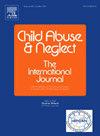从交叉视角看西班牙青年代表性样本中性剥削的普遍性和相关特征。
IF 3.4
2区 心理学
Q1 FAMILY STUDIES
引用次数: 0
摘要
背景:儿童性剥削(CSE)涉及利用儿童或青少年作为性对象,以换取报酬、奖励或好处,满足他们的生存需要,同时也服务于犯罪者的性、社会或经济利益的目的。目的:本研究旨在了解西班牙CSE的流行情况。调查对象:选取具有代表性的14 ~ 17岁中学生4024人(M = 15.42, SD = 1.034)进行调查。方法:三个问题改编自以前的欧洲研究的主题。结果:总体患病率为2.6%,包括交换性材料(1.7%),性接触(0.9%)和涉及口交或插入的性关系(0.9%)。虽然没有出现明显的年龄相关差异,但观察到性别特有的模式。男孩口交和插入性行为的发生率明显高于女孩(1.2%比0.5%),而女孩交换性材料的发生率略高于男孩(2%比1.2%)。LGB青少年报告的CSE风险明显高于异性恋青少年(5.5%对2.1%),欧洲青少年报告的CSE风险低于其他种族的青少年(2.2%对4.1%)。结论:CSE应该引起社会关注,因为它影响了全世界大量的儿童。干预措施应采用交叉视角,将与这种形式的受害有关的各种风险因素纳入其中。本文章由计算机程序翻译,如有差异,请以英文原文为准。
Prevalence and associated characteristics of sexual exploitation in a representative sample of spanish youth from an intersectional perspective
Background
Child sexual exploitation (CSE) involves using a child or youth as a sexual object in exchange for remuneration, reward, or favors, meeting their survival needs, and also serving the perpetrator's aims for sexual, social, or economic gain.
Objective
The present study addresses the prevalence of CSE in Spain. Participants: A representative sample of 4024 secondary school adolescents from 14 to 17 years old (M = 15.42, SD = 1.034) was surveyed.
Methods
Three questions adapted from previous European studies on the topic were used.
Results
An overall prevalence of 2.6 % was recorded, comprising exchange of sexual material (1.7 %), sexual touching (0.9 %), and sexual relations involving oral sex or penetration (0.9 %). While no significant age-related differences emerged, gender-specific patterns were observed. Boys exhibited a significantly higher prevalence of oral and penetrative sex than girls (1.2 % vs 0.5 %), while girls showed a slightly higher prevalence of exchange of sexual material (2 % vs 1.2 %) than boys. LGB youth reported a significantly higher risk for CSE than heterosexual youth (5.5 % vs 2.1 %), and European adolescents reported less CSE (2.2 % vs. 4.1 %) than youths from other ethnicities.
Conclusions
CSE should be a social concern because it affects a substantial number of children worldwide. Interventions should adopt an intersectional perspective that incorporates the various risk factors associated with this form of victimization.
求助全文
通过发布文献求助,成功后即可免费获取论文全文。
去求助
来源期刊

Child Abuse & Neglect
Multiple-
CiteScore
7.40
自引率
10.40%
发文量
397
期刊介绍:
Official Publication of the International Society for Prevention of Child Abuse and Neglect. Child Abuse & Neglect The International Journal, provides an international, multidisciplinary forum on all aspects of child abuse and neglect, with special emphasis on prevention and treatment; the scope extends further to all those aspects of life which either favor or hinder child development. While contributions will primarily be from the fields of psychology, psychiatry, social work, medicine, nursing, law enforcement, legislature, education, and anthropology, the Journal encourages the concerned lay individual and child-oriented advocate organizations to contribute.
 求助内容:
求助内容: 应助结果提醒方式:
应助结果提醒方式:


